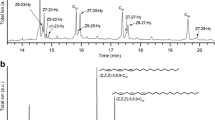Abstract
Male spruce budworm [Chorisloneura fumiferana (Clem.)] moths were held for 3 hr in a wind tunnel and subjected to various concentrations of background synthetic pheromone. They were then exposed to calling females and their response was recorded. The background pheromone was presented either as discrete turbulent plumes or as a uniform permeation throughout the tunnel. The numbers of males wing-fanning and flying in response to the calling females decreased as the concentration of background pheromone increased. Of the males which flew, a higher proportion progressed upwind in the discrete plumes than in the uniform permeation, an indication that structure in the pheromone cloud is necessary for upwind progression. In both discrete plumes and uniform permeation fewer males were able to locate the females (i.e., disruption was greater) as the concentration of synthetic pheromone increased, but for the same total release rates, disruption was greater when the synthetic pheromone was released in discrete plumes rather than in a uniform permeation. This implies that disruption which involves luring males to sources of synthetic pheromone is more effective than masking female plumes by uniform permeation and suggests that it is more efficient to release pheromone from a few potent sources than from numerous low-potency sources.
Similar content being viewed by others
References
Bierl-Leonhardt, B.A., De Vilbiss, E.D., andPlimmer, J.R. 1979. Rate of release of disparlure from laminated plastic dispensers.J. Econ. Entomol. 72:319–321.
Cardé, R.T. 1981. Disruption of long-distance pheromone communication in the oriental fruit moth: Camouflaging the natural aerial trails from females, pp. 385–398in E.R. Mitchell (ed.). Management of insect pests with semiochemicals. Plenum Press, New York.
Cardé, R.T., andHagaman, T.E. 1979. Behavioral responses of the gypsy moth in a wind tunnel to air-borne enantiomers of disparlure.Environ. Entomol 8:475–484.
Carles, J.P., Fleurat-Lessard, F., andRoehrich, R. 1979. Un appareil pour les essais biologiques de comportement de lépidoptères exposé's à des doses élevées d'attractif sexuel.Biol. Behav. 1979(4):205–217.
Caro, J.H., Bierl, B.A., Freeman, H.P., Glotfelty, D.E., andTurner, B.C. 1977. Disparlure: Volatilization rates of two microencapsulated formulations from a grass field.Environ. Entomol. 6:877–881.
Caro, J.H., Glotfelty, D.E., andFreeman, H.P. 1980. (Z)-9-Tetradecen-1-ol formate: Distribution and dissipation in the air within a corn crop after emission from a controlled-release formulation.J. Chem. Ecol. 6:229–239.
Daterman, G.E. 1974. Synthetic sex pheromone for detection survey of European pine shoot moth. USDA For. Serv., Res. Pap. PNW-180, 12 pp.
Farkas, S.R., Shorey, H.H., Gaston, L.K. 1974. Sex pheromones of Lepidoptera. The use of widely separated evaporators of loop-lure for the disruption of pheromone communication inTrichoplusia ni.Environ. Entomol. 5:876–877.
Fitzgerald, T.D., St. Clair, A.D., Daterman, G.E., andSmith, R.G. 1973. Slow release formulation of the cabbage looper pheromonecis-7-dodecenyl acetate: Release rate and biological activity.Environ. Entomol. 2:707–610.
Gaston, L.K., andShorey, H.H. 1974. Pages 425–526,in M. Birch (ed.). Pheromones. North-Holland, Amsterdam.
Gentry, C.R., Bierl-Leonhardt, B.A., Blythe, F.L., andPlimmer, J.R. 1980. Air permeation with Orfralure for reductionin trap catch of oriental fruit moth.J. Chem. Ecol. 6:185–192.
Harvey, T.G. 1974. Nutritional studies of eastern spruce budworm (Lepidoptera: Tortricidae). I. Soluble sugar.Can. Entomol. 106:353–365.
Kennedy, J.S., Ludlow, A.R., andSanders, C.J. 1980. Guidance system used in moth sex attraction.Nature 288:475–477.
Kennedy, J.S., Ludlow, A.R., andSanders, C.J. 1981. Guidance of flying male moths in wind-borne sex pheromone.Physiol. Entomol. 6:395–412.
Mcmorran, A. 1965. A synthetic diet for the spruce budwormChoristoneura fumiferana (Clem.) (Lepidoptera: Tortricidae).Can. Entomol. 97:58–68.
Murlis, J., andJones, C.D. 1981. Fine scale structure odour plumes in relation to insect orientation to distant pheromone and other attractant sources.Physiol. Entomol. 6:71–86.
Plimmer, J.R., Caro, J.H., andFreeman, H.P. 1978. Distribution and dissipation of aerially applied disparlure under a woodland canopy.J. Econ. Entomol. 71:155–157.
Richerson, J.V. 1977. Pheromone-mediated behavior of the gypsy moth.J. Chem. Ecol. 3:291–298.
Sanders, C.J. 1981. Release rates and attraction of PVC lures containing synthetic attractant of the spruce budworm,Choristoneura fumiferana.Can. Entomol. 102:103–111.
Sanders, C.J., andLucuik, G.S. 1972. Factors affecting calling by female eastern spruce budworm,Choristoneura fumiferana (Lepidoptera: Tortricidae).Can. Entomol. 104:1751–1762.
Sanders, C.J., andWeatherston, J. 1976. Sex pheromone of the eastern spruce budworm: Optimum blend oftrans- andcis11-tetradecenal.Can. Entomol. 108:1285–1290.
Schmidt, J.O., andSeabrook, W.D. 1979. Mating of caged spruce budworm moths in pheromone environments.J. Econ. Entomol. 72:509–511.
Schwalbe, C.P., Paszek, E.C., Webb, R.E., Bierl-Leonhardt, B.A., Plimmer, J.R., McComb, C.W., andDull, C.W. 1979. Field evaluation of controlled-release formulation of disparlure for gypsy moth mating disruption.J. Econ. Entomol. 72:322–326.
Shorey, H.H., andGaston, L.K. 1974. Pages 421–425,in M.C. Birch (ed.). Pheromones. North-Holland, Amsterdam.
Silk, P.J., Tan, S.H., Wiesner, C.J., Ross, R.J., andLonergan, G.C. 1980. Sex pheromone chemistry of the eastern spruce budworm.Environ. Entomol. 9:640–644.
Taschenberg, E.F., andRoelofs, W.L. 1976. Pheromone communication disruption of the grape berry moth with microencapsulated and holly fibre system.Environ. Entomol. 5:688–691.
Wiesner, C.J., Silk, P.J., Tan, S.H., andFullarton, S. 1980. Monitoring of atmospheric concentrations of the sex pheromone of the spruce budworm,Choristoneura fumiferana (Lepidoptera: Tortricidae).Can. Entomol. 112:333–334.
Author information
Authors and Affiliations
Rights and permissions
About this article
Cite this article
Sanders, C.J. Disruption of male spruce budworm orientation to calling females in a wind tunnel by synthetic pheromone. J Chem Ecol 8, 493–506 (1982). https://doi.org/10.1007/BF00987797
Received:
Revised:
Issue Date:
DOI: https://doi.org/10.1007/BF00987797




